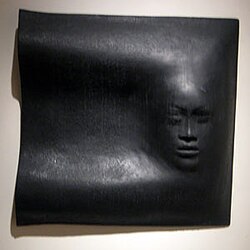Gwen Lux
Gwen Lux | |
|---|---|
 Gwen Lux in her studio | |
| Born | Gwen Wickerts November 17, 1908 Chicago, Illinois, U.S. |
| Died | 2001 (aged 92–93) Honolulu, Hawaii, U.S. |
| Nationality | American |
| Other names | Gwen Creighton Lux, Gwen Lux Creighton, Gwen Wickerts Lux |
| Education | Maryland Institute College of Art, School of the Museum of Fine Arts, Boston |
| Known for | Sculpture |
Gwen Lux Creighton professionally Gwen Lux, (1908–1986)[1] was an American sculptor known for her abstraction and frequently constructed from polyester resin concrete and metals. She was among America’s pioneer women sculptors.[2]
Biography[]
Gwen Wickerts was born in Chicago, Illinois on November 17, 1908.[3] She began her art studies in Detroit at age 14, taking classes with potter, Mary Chase Perry Stratton at Pewabic Pottery.[4] She later studied at and between 1923–1926.[3] Followed by a year of study at Maryland Institute College of Art (MICA) from 1926 until 1927, and at the School of the Museum of Fine Arts, Boston from 1927 until 1928.[3] In 1933, she received a Guggenheim Fellowship for Fine Art.[3]
Lux lived and worked in Detroit, Michigan in the early part of her career, and then moved to Honolulu, Hawaii in 1973.
Her first marriage was to fellow sculptor Eugene "Gene" J. Lux, which ended in divorce.[5] In 1959, she married Thomas Hawk Creighton, a longtime editor of Progressive Architecture magazine.[5] Thomas Hawk Creighton died in 1984 in Hawaii.[6] In 1986, Lux married, to her longtime friend and companion Jerome R. Wallace, a well-known artist who created batiks using natural dyes found in the local environment on the island of Kauai, Hawaii.[citation needed]

Notable commissions[]
Her commissions included sculptures for Radio City Music Hall in New York City, the McGraw-Hill Building in Chicago, the General Motors Technical Center in Detroit, and the centerpiece for the first class dining room of the SS United States The Detroit Institute of Arts, the Hawaii State Art Museum, the Kresge Art Museum (Michigan State University, East Lansing) and the Mariners' Museum (Newport News, Virginia) are among the public collections holding her work.
Her sculptures combined abstraction and realism, and were frequently constructed from polyester resin concrete and metals. She taught sculpture classes at the Arts & Crafts Society of Detroit.

Further reading[]
- Collins, Jim L. Women Artists in America II, Chattanooga, Tenn., Collins, 1975.
- Heller, Jules and Nancy G. Heller, North American Women Artists of the Twentieth Century: A Biographical Dictionary, New York, Garland, 1995.
- Roussel, Christine, The Guide to the Art of Rockefeller Center, New York, W.W. Norton, 2006.
- Rubinstein, Charlotte Streifer, American Women Sculptors: A History of Women Working in Three Dimensions, Boston, G.K. Hall, 1990.
References[]
- ^ "Gwen Creighton Lux (1908 - 2001)". AskART. Retrieved 2019-01-03.
- ^ McBrien, Judith Paine (2004). Pocket Guide to Chicago Architecture. New York: W. W. Norton & Company. p. 39.
- ^ Jump up to: a b c d "Gwen Lux". John Simon Guggenheim Foundation. Retrieved 2019-01-04.
- ^ Barrie, Bentley, Helms and Rospond, ‘’Artists in Michigan, 1900-1976: A biographical dictionary’’, Wayne State University Press, Detroit, MI, 1989
- ^ Jump up to: a b "Mrs. Gwen Lux Wed To T. H. Creighton". The New York Times, TimeMachine. 1959. Retrieved 2019-01-03.
- ^ "Thomas Creighton, Architect And Editor, Dies in Honolulu". The New York Times. 1984-10-19. ISSN 0362-4331. Retrieved 2019-01-04.
External links[]
- 1908 births
- 2001 deaths
- American women sculptors
- Artists from Hawaii
- Modern sculptors
- 20th-century American sculptors
- 20th-century American women artists
- Maryland Institute College of Art alumni
- School of the Museum of Fine Arts at Tufts alumni